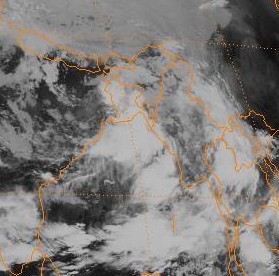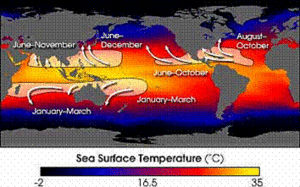Monsoon trough facts for kids
The monsoon trough is a long area of low air pressure that is part of a bigger weather system called the Intertropical Convergence Zone (ITCZ). You can see it on a weather map as a line showing where the air pressure is lower.
How it Affects Weather
Bringing Rain

The monsoon trough is a place where winds come together. This low-pressure area pulls in moist air, creating long bands of thunderstorms. When the monsoon trough moves north, it often marks the start of the rainy season in places like South and East Asia.
This meeting point of winds has caused very heavy rain in areas like the Yangtze river in China. It also brings the peak of the rainy season to parts of Australia. When the trough moves away from a certain spot, the weather usually becomes clear, hot, and dry. Many of the world's rainforests are found in areas affected by these low-pressure systems.
Forming Tropical Cyclones
The monsoon trough is an important area where tropical cyclones (like hurricanes or typhoons) often form. This is because the air near the ground in the trough already has a lot of 'spin' or rotation. This natural spin helps new storms get started and grow stronger.
There seems to be a cycle of thunderstorm activity along the monsoon trough, happening every 15 to 25 days. This matches how tropical cyclones form in groups, with periods of activity followed by quiet times.
The way the monsoon trough is angled can affect where tropical cyclones go. If it's angled from east-southeast to west-northwest, storms usually move west. If it's angled southwest to northeast, storms might move more towards the poles.
In the eastern Pacific Ocean and Atlantic Ocean, tropical cyclones usually don't form south of the equator. This is partly because the monsoon trough, or ITCZ, doesn't move south enough in those areas during the Southern Hemisphere summer. Also, when the monsoon trough is near 20 degrees north latitude in the Pacific, tropical cyclones form 2 to 3 times more often than when it's closer to 10 degrees north.
Images for kids





